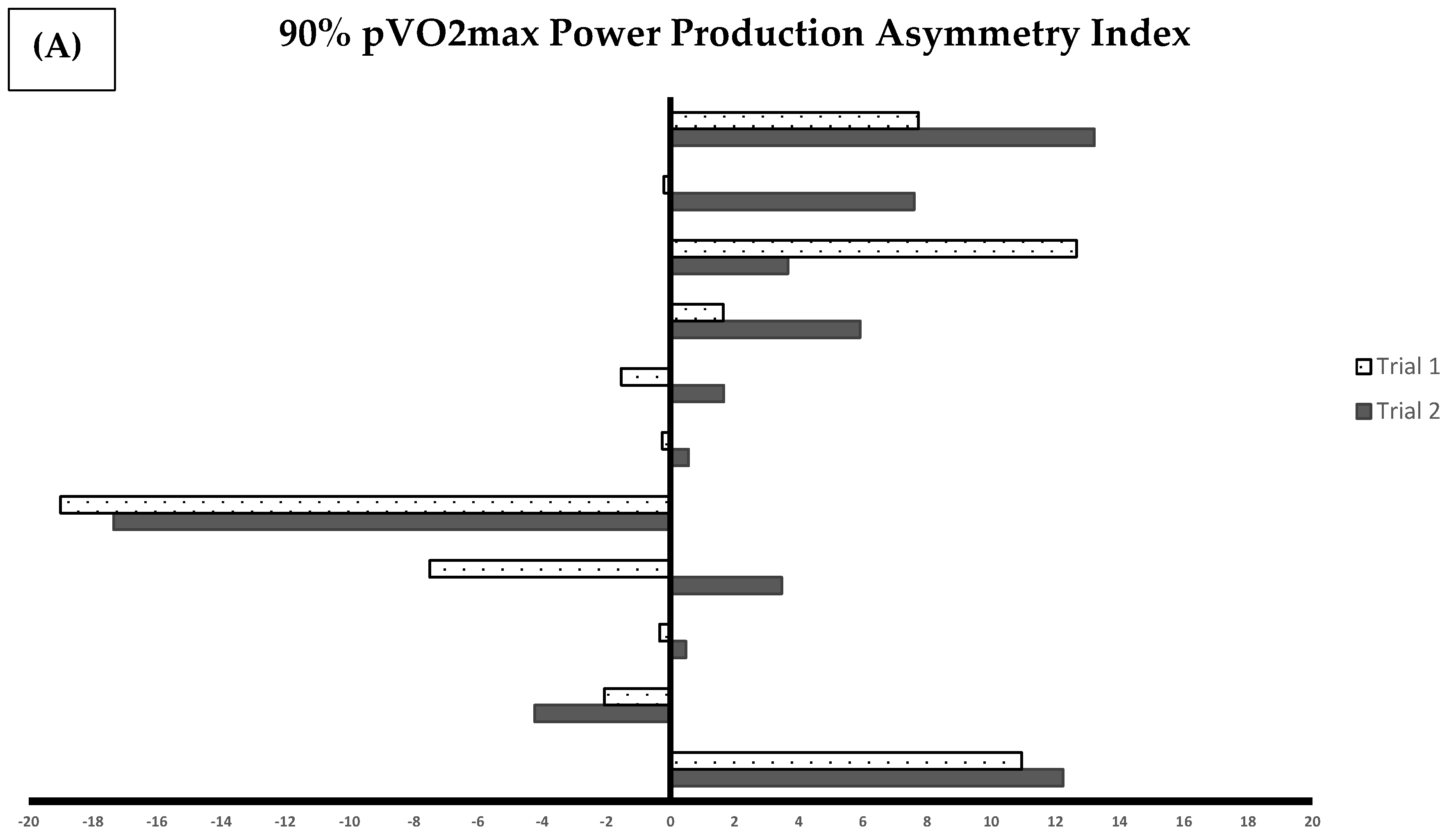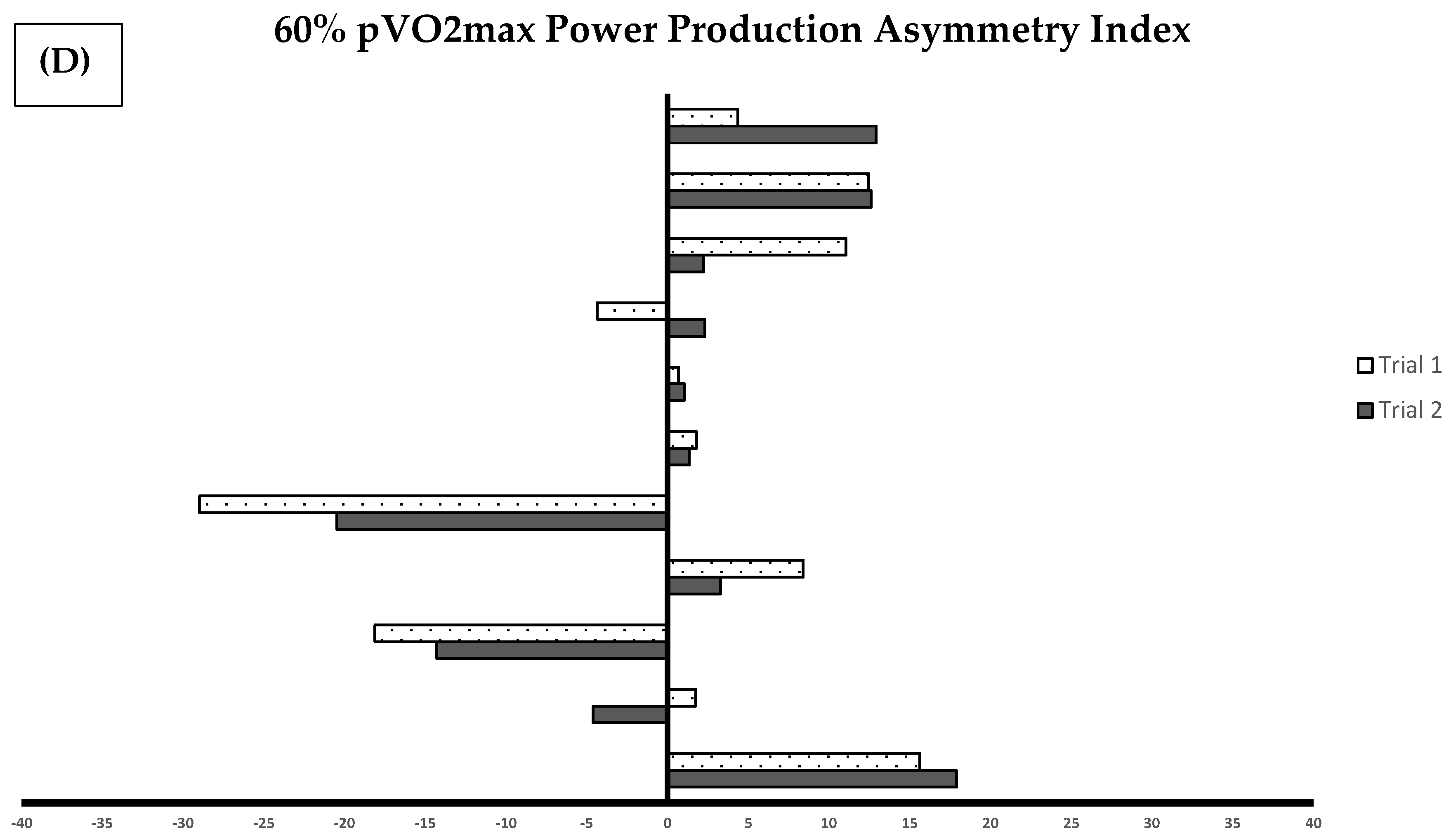Contralateral Asymmetry in Cycling Power Is Reproducible and Independent of Exercise Intensity at Submaximal Power Outputs
Abstract
1. Introduction
2. Materials and Methods
2.1. Participants
2.2. Methodology
2.3. Statistical Analysis
3. Results
4. Discussion
5. Conclusions
Author Contributions
Funding
Institutional Review Board Statement
Data Availability Statement
Conflicts of Interest
References
- Bailey, C.A.; Sato, K.; McInnis, T.C. A Technical Report on Reliability Measurement in Asymmetry Studies. J. Strength Cond. Res. 2021, 35, 1779–1783. [Google Scholar] [CrossRef] [PubMed]
- Carpes, F.P. On the Bilateral Asymmetry during Running and Cycling—A Review Considering Leg Preference. Phys. Ther. Sport 2010, 11, 136–142. [Google Scholar] [CrossRef] [PubMed]
- Bell, D.R.; Sanfilippo, J.L.; Binkley, N.; Heiderscheit, B.C. Lean Mass Asymmetry Influences Force and Power Asymmetry during Jumping in Collegiate Athletes. J. Strength Cond. Res. 2014, 28, 884–891. [Google Scholar] [CrossRef] [PubMed]
- Hoffman, J.R.; Ratamess, N.A.; Klatt, M.; Faigenbaum, A.D.; Kang, J. Do Bilateral Power Deficits Influence Direction-Specific Movement Patterns? Res. Sport. Med. 2007, 15, 125–132. [Google Scholar] [CrossRef]
- Bishop, C.; Turner, A.; Read, P. Effects of Inter-Limb Asymmetries on Physical and Sports Performance: A Systematic Review. J. Sport. Sci. 2018, 36, 1135–1144. [Google Scholar] [CrossRef]
- Barber, S.D.; Noyes, F.R.; Mangine, R.E.; Mccloskey, J.W.; Hartman, W. Quantitative Assessment of Functional Limitations in Normal and Anterior Cruciate Ligament-Deficient Knees. Clin. Orthop. Relat. Res. 1990, 255, 204214. [Google Scholar] [CrossRef]
- Grindem, H.; Logerstedt, D.; Eitzen, I.; Moksnes, H.; Axe, M.J.; Snyder-Mackler, L.; Engebretsen, L.; Risberg, M.A. Single-Legged Hop Tests as Predictors of Self-Reported Knee Function in Nonoperatively Treated Individuals with Anterior Cruciate Ligament Injury. Am. J. Sport. Med. 2011, 39, 2347–2354. [Google Scholar] [CrossRef]
- van Melick, N.; Meddeler, B.M.; Hoogeboom, T.J.; Nijhuis-van der Sanden, M.W.G.; van Cingel, R.E.H. How to Determine Leg Dominance: The Agreement between Self-Reported and Observed Performance in Healthy Adults. PLoS ONE 2017, 12, e0189876. [Google Scholar] [CrossRef]
- Faria, E.W.; Parker, D.L.; Faria, I.E. The Science of Cycling: Physiology and Training—Part 1. Sport. Med. 2005, 35, 285–312. [Google Scholar] [CrossRef]
- Bini, R.R.; Jacques, T.C.; Sperb, C.H.; Lanferdini, F.J.; Vaz, M.A. Pedal Force Asymmetries and Performance during a 20-km Cycling Time Trial. Kinesiology 2016, 48, 193–199. [Google Scholar] [CrossRef]
- Bini, R.R.; Hume, P.A. Assessment of Bilateral Asymmetry in Cycling Using a Commercial Instrumented Crank System and Instrumented Pedals. Int. J. Sport. Physiol. Perform. 2014, 9, 876–881. [Google Scholar] [CrossRef]
- Farrell, J.W. Effects of Exercise Intensity on Pedal Force Asymmetry during Cycling. Symmetry 2021, 13, 1499. [Google Scholar] [CrossRef]
- Carpes, F.; Rossato, M.; Faria, I.; Mota, C.B. During a Simulated 40-km Cycling Time-Trial. J. Sport. Med. Phys. Fit 2007, 47, 51–57. [Google Scholar]
- Bishop, C.; McAuley, W.; Read, P.; Gonzalo-Skok, O.; Lake, J.; Turner, A. Acute Effect of Repeated Sprints on Interlimb Asymmetries during Unilateral Jumping. J. Strength Cond. Res. 2021, 35, 2127–2132. [Google Scholar] [CrossRef]
- Bromley, T.; Turner, A.; Read, P.; Lake, J.; Maloney, S.; Chavda, S.; Bishop, C. Effects of a Competitive Soccer Match on Jump Performance and Interlimb Asymmetries in Elite Academy Soccer Players. J. Strength Cond. Res. 2018, 35, 1707–1714. [Google Scholar] [CrossRef]
- Blagrove, R.C.; Bishop, C.; Howatson, G.; Hayes, P.R. Inter-Limb Strength Asymmetry in Adolescent Distance Runners: Test-Retest Reliability and Relationships with Performance and Running Economy. J. Sport. Sci. 2021, 39, 312–321. [Google Scholar] [CrossRef]
- Sanders, D.; van Erp, T. The Physical Demands and Power Profile of Professional Men’s Cycling Races: An Updated Review. Int. J. Sport. Physiol. Perform. 2021, 16, 3–12. [Google Scholar] [CrossRef]
- George, J.D.; Stone, W.J.; Burkett, L.N. Non-Exercise VO2max Estimation for Physically Active College Students. Med. Sci. Sport. Exerc. 1997, 29, 415–423. [Google Scholar] [CrossRef]
- Jamnick, N.A.; By, S.; Pettitt, C.D.; Pettitt, R.W. Comparison of the YMCA and a Custom Submaximal Exercise Test for Determining VO2max. Med. Sci. Sport. Exerc. 2016, 48, 254–259. [Google Scholar] [CrossRef]
- Driller, M.W. The Reliability of a 30-Minute Performance Test on a Lode Cycle Ergometer. J. Sci. Cycl. 2012, 1, 7. [Google Scholar]
- Sedgeman, D.; Dalleck, L.; Clark, I.; Jamnick, N.; Pettitt, R. Analysis of Square-Wave Bouts to Verify VO2max. Int. J. Sport. Med. 2013, 34, 1058–1062. [Google Scholar] [CrossRef] [PubMed]
- Virgile, A.; Bishop, C. A Narrative Review of Limb Dominance: Task Specificity and the Importance of Fitness Testing. J. Strength Cond. Res. 2021, 35, 846–858. [Google Scholar] [CrossRef] [PubMed]
- Fleiss, J.L. Reliability of Measurement. In The Design and Analysis of Clinical Experiments; John Wiley & Sons: Hoboken, NJ, USA, 1986. [Google Scholar] [CrossRef]
- Olejnik, S.; Algina, J. Generalized Eta and Omega Squared Statistics: Measures of Effect Size for Some Common Research Designs. Psychol. Methods 2003, 8, 434–447. [Google Scholar] [CrossRef] [PubMed]
- Pauw, K.D.; Roelands, B.; Cheung, S.S.; de Geus, B.; Rietjens, G.; Meeusen, R. Guidelines to Classify Subject Groups in Sport-Science Research. Int. J. Sport. Physiol. Perform. 2013, 8, 111–122. [Google Scholar] [CrossRef] [PubMed]
- Bini, R.R.; Jacques, T.C.; Carpes, F.P.; Vaz, M.A. Effectiveness of Pedalling Retraining in Reducing Bilateral Pedal Force Asymmetries. J. Sport. Sci. 2017, 35, 1336–1341. [Google Scholar] [CrossRef]
- Carpes, F.P.; Rossato, M.; Faria, I.E.; Mota, C.B. During an Incremental Exercise Cyclists Improve Bilateral Pedaling Symmetry. Braz. J. Biomot. 2008, 2, 155–159. [Google Scholar]
- García-López, J.; Díez-Leal, S.; Larrazabal, J.; Ogueta-Alday, A. No Bilateral Asymmetry during Pedalling in Healthy Cyclists of Different Performance Levels. In Proceedings of the 33rd International Conference of Biomechanics in Sports, Poitiers, France, 29 June–3 July 2015; p. 4. [Google Scholar]
- Heil, J.; Loffing, F.; Büsch, D. The Influence of Exercise-Induced Fatigue on Inter-Limb Asymmetries: A Systematic Review. Sport. Med.-Open 2020, 6, 39. [Google Scholar] [CrossRef]
- Pimentel, R.E.; Baker, B.S.; Soliday, K.; Reiser, R.F. Bone Mineral Density and Lean Mass Asymmetries Are Greater in Cyclists than Non-Cyclists. J. Sport. Sci. 2019, 37, 2279–2285. [Google Scholar] [CrossRef]
- Bishop, C.; Read, P.; McCubbine, J.; Turner, A. Vertical and Horizontal Asymmetries Are Related to Slower Sprinting and Jump Performance in Elite Youth Female Soccer Players. J. Strength Cond. Res. 2021, 35, 56–63. [Google Scholar] [CrossRef]
- dos Santos, K.; Pereira, G.; Papoti, M.; Bento, P.C.; Rodacki, A. Propulsive Force Asymmetry during Tethered-Swimming. Int. J. Sport. Med. 2013, 34, 606–611. [Google Scholar] [CrossRef]
- Hart, N.H.; Nimphius, S.; Spiteri, T.; Newton, R.U. Leg Strength and Lean Mass Symmetry Influences Kicking Performance in Australian Football. J. Sport. Sci. Med. 2014, 13, 157–165. [Google Scholar]
- Bishop, C.; Read, P.; Chavda, S.; Jarvis, P.; Turner, A. Using Unilateral Strength, Power and Reactive Strength Tests to Detect the Magnitude and Direction of Asymmetry: A Test-Retest Design. Sports 2019, 7, 58. [Google Scholar] [CrossRef]
- Bishop, C.; Read, P.; Lake, J.; Loturco, I.; Dawes, J.; Madruga, M.; Romero-Rodrigues, D.; Chavda, S.; Turner, A. Unilateral Isometric Squat: Test Reliability, Interlimb Asymmetries, and Relationships with Limb Dominance. J. Strength Cond. Res. 2021, 35, S144–S151. [Google Scholar] [CrossRef]
- Dos’Santos, T.; Thomas, C.; Comfort, P.; McMahon, J.J.; Jones, P.A.; Oakley, N.P.; Young, A.L. Between-Session Reliability of Isometric Midthigh Pull Kinetics and Maximal Power Clean Performance in Male Youth Soccer Players. J. Strength Cond. Res. 2018, 32, 3364–3372. [Google Scholar] [CrossRef]
- Bishop, C.; Read, P.; Bromley, T.; Brazier, J.; Jarvis, P.; Chavda, S.; Turner, A. The Association between Interlimb Asymmetry and Athletic Performance Tasks: A Season-Long Study in Elite Academy Soccer Players. J. Strength Cond. Res. 2022, 36, 787–795. [Google Scholar] [CrossRef]
- Madruga-Parera, M.; Bishop, C.; Fort-Vanmeerhaeghe, A.; Beltran-Valls, M.R.; Skok, O.G.; Romero-Rodríguez, D. Interlimb Asymmetries in Youth Tennis Players: Relationships with Performance. J. Strength Cond. Res. 2020, 34, 2815–2823. [Google Scholar] [CrossRef]
- Pardos-Mainer, E.; Casajús, J.A.; Gonzalo-Skok, O. Adolescent Female Soccer Players’ Soccer-Specific Warm-Upeffects on Performance and Inter-Limb Asymmetries. Biol. Sport 2019, 36, 199–207. [Google Scholar] [CrossRef]



| Variable | Visit 1 (Mean ± SD) | Visit 2 (Mean ± SD) | ICC r (95% CI) | p | CV | SEM |
|---|---|---|---|---|---|---|
| 60% pVO2max AI (%) | 0.4 ± 13.4 | 1.3 ± 11.4 | 0.945 (0.797–0.985) | 0.00 | 612.9 | 1.9 |
| 70% pVO2max AI (%) | 1.3 ± 15.6 | −0.8 ± 10.3 | 0.792 (0.223–0.944) | 0.01 | 594.0 | 4.8 |
| 80% pVO2max AI (%) | 1.9 ± 13.8 | 1.6 ± 9.4 | 0.777 (0.118–0.941) | 0.02 | 4267.5 | 5.46 |
| 90% pVO2max AI (%) | 0.1 ± 8.8 | 2.5 ± 8.3 | 0.888 (0.604–0.969) | 0.00 | 1404.5 | 5.51 |
Disclaimer/Publisher’s Note: The statements, opinions and data contained in all publications are solely those of the individual author(s) and contributor(s) and not of MDPI and/or the editor(s). MDPI and/or the editor(s) disclaim responsibility for any injury to people or property resulting from any ideas, methods, instructions or products referred to in the content. |
© 2023 by the authors. Licensee MDPI, Basel, Switzerland. This article is an open access article distributed under the terms and conditions of the Creative Commons Attribution (CC BY) license (https://creativecommons.org/licenses/by/4.0/).
Share and Cite
Farrell, J.W., III; Neira, V.E. Contralateral Asymmetry in Cycling Power Is Reproducible and Independent of Exercise Intensity at Submaximal Power Outputs. Symmetry 2023, 15, 1142. https://doi.org/10.3390/sym15061142
Farrell JW III, Neira VE. Contralateral Asymmetry in Cycling Power Is Reproducible and Independent of Exercise Intensity at Submaximal Power Outputs. Symmetry. 2023; 15(6):1142. https://doi.org/10.3390/sym15061142
Chicago/Turabian StyleFarrell, John W., III, and Valerie E. Neira. 2023. "Contralateral Asymmetry in Cycling Power Is Reproducible and Independent of Exercise Intensity at Submaximal Power Outputs" Symmetry 15, no. 6: 1142. https://doi.org/10.3390/sym15061142
APA StyleFarrell, J. W., III, & Neira, V. E. (2023). Contralateral Asymmetry in Cycling Power Is Reproducible and Independent of Exercise Intensity at Submaximal Power Outputs. Symmetry, 15(6), 1142. https://doi.org/10.3390/sym15061142






